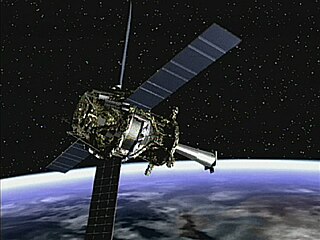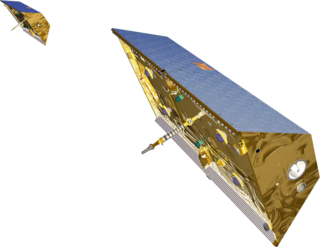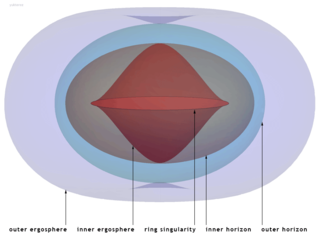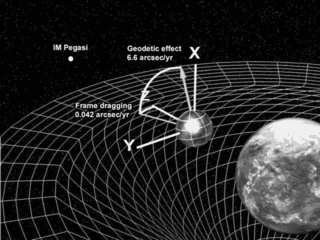Related Research Articles

General relativity, also known as the general theory of relativity and Einstein's theory of gravity, is the geometric theory of gravitation published by Albert Einstein in 1915 and is the current description of gravitation in modern physics. General relativity generalises special relativity and refines Newton's law of universal gravitation, providing a unified description of gravity as a geometric property of space and time or four-dimensional spacetime. In particular, the curvature of spacetime is directly related to the energy and momentum of whatever matter and radiation are present. The relation is specified by the Einstein field equations, a system of second order partial differential equations.
The following is a timeline of gravitational physics and general relativity.
In theoretical physics, particularly in discussions of gravitation theories, Mach's principle is the name given by Albert Einstein to an imprecise hypothesis often credited to the physicist and philosopher Ernst Mach. The hypothesis attempted to explain how rotating objects, such as gyroscopes and spinning celestial bodies, maintain a frame of reference.

The Laser Interferometer Space Antenna (LISA) is a proposed space probe to detect and accurately measure gravitational waves—tiny ripples in the fabric of spacetime—from astronomical sources. LISA would be the first dedicated space-based gravitational-wave observatory. It aims to measure gravitational waves directly by using laser interferometry. The LISA concept has a constellation of three spacecraft arranged in an equilateral triangle with sides 2.5 million kilometres long, flying along an Earth-like heliocentric orbit. The distance between the satellites is precisely monitored to detect a passing gravitational wave.

Gravity Probe B (GP-B) was a satellite-based experiment to test two unverified predictions of general relativity: the geodetic effect and frame-dragging. This was to be accomplished by measuring, very precisely, tiny changes in the direction of spin of four gyroscopes contained in an Earth-orbiting satellite at 650 km (400 mi) of altitude, crossing directly over the poles.

In satellite laser ranging (SLR) a global network of observation stations measures the round trip time of flight of ultrashort pulses of light to satellites equipped with retroreflectors. This provides instantaneous range measurements of millimeter level precision which can be accumulated to provide accurate measurement of orbits and a host of important scientific data. The laser pulse can also be reflected by the surface of a satellite without a retroreflector, which is used for tracking space debris.

In the theory of general relativity, the equivalence principle is the equivalence of gravitational and inertial mass, and Albert Einstein's observation that the gravitational "force" as experienced locally while standing on a massive body is the same as the pseudo-force experienced by an observer in a non-inertial (accelerated) frame of reference.
The Pioneer anomaly, or Pioneer effect, was the observed deviation from predicted accelerations of the Pioneer 10 and Pioneer 11 spacecraft after they passed about 20 astronomical units (3×109 km; 2×109 mi) on their trajectories out of the Solar System. The apparent anomaly was a matter of much interest for many years but has been subsequently explained by anisotropic radiation pressure caused by the spacecraft's heat loss.

The Gravity Recovery and Climate Experiment (GRACE) was a joint mission of NASA and the German Aerospace Center (DLR). Twin satellites took detailed measurements of Earth's gravity field anomalies from its launch in March 2002 to the end of its science mission in October 2017. The two satellites were sometimes called Tom and Jerry, a nod to the famous cartoon. The GRACE Follow-On (GRACE-FO) is a continuation of the mission on near-identical hardware, launched in May 2018.

The ergosphere is a region located outside a rotating black hole's outer event horizon. Its name was proposed by Remo Ruffini and John Archibald Wheeler during the Les Houches lectures in 1971 and is derived from the Greek word ἔργον (ergon), which means "work". It received this name because it is theoretically possible to extract energy and mass from this region. The ergosphere touches the event horizon at the poles of a rotating black hole and extends to a greater radius at the equator. A black hole with modest angular momentum has an ergosphere with a shape approximated by an oblate spheroid, while faster spins produce a more pumpkin-shaped ergosphere. The equatorial (maximal) radius of an ergosphere is the Schwarzschild radius, the radius of a non-rotating black hole. The polar (minimal) radius is also the polar (minimal) radius of the event horizon which can be as little as half the Schwarzschild radius for a maximally rotating black hole.
Tests of general relativity serve to establish observational evidence for the theory of general relativity. The first three tests, proposed by Albert Einstein in 1915, concerned the "anomalous" precession of the perihelion of Mercury, the bending of light in gravitational fields, and the gravitational redshift. The precession of Mercury was already known; experiments showing light bending in accordance with the predictions of general relativity were performed in 1919, with increasingly precise measurements made in subsequent tests; and scientists claimed to have measured the gravitational redshift in 1925, although measurements sensitive enough to actually confirm the theory were not made until 1954. A more accurate program starting in 1959 tested general relativity in the weak gravitational field limit, severely limiting possible deviations from the theory.
In 19th century physics, there were several situations in which the motion of matter might be said to drag light. This aether drag hypothesis was an attempt by classical physics to explain stellar aberration and the Fizeau experiment, but was discarded when Albert Einstein introduced his theory of relativity. Despite this, the expression light-dragging has remained in use somewhat, as discussed on this page.

The geodetic effect represents the effect of the curvature of spacetime, predicted by general relativity, on a vector carried along with an orbiting body. For example, the vector could be the angular momentum of a gyroscope orbiting the Earth, as carried out by the Gravity Probe B experiment. The geodetic effect was first predicted by Willem de Sitter in 1916, who provided relativistic corrections to the Earth–Moon system's motion. De Sitter's work was extended in 1918 by Jan Schouten and in 1920 by Adriaan Fokker. It can also be applied to a particular secular precession of astronomical orbits, equivalent to the rotation of the Laplace–Runge–Lenz vector.
In general relativity, Lense–Thirring precession or the Lense–Thirring effect is a relativistic correction to the precession of a gyroscope near a large rotating mass such as the Earth. It is a gravitomagnetic frame-dragging effect. It is a prediction of general relativity consisting of secular precessions of the longitude of the ascending node and the argument of pericenter of a test particle freely orbiting a central spinning mass endowed with angular momentum .

Gravitoelectromagnetism, abbreviated GEM, refers to a set of formal analogies between the equations for electromagnetism and relativistic gravitation; specifically: between Maxwell's field equations and an approximation, valid under certain conditions, to the Einstein field equations for general relativity. Gravitomagnetism is a widely used term referring specifically to the kinetic effects of gravity, in analogy to the magnetic effects of moving electric charge. The most common version of GEM is valid only far from isolated sources, and for slowly moving test particles.

LARES is a passive satellite system of the Italian Space Agency.
Frame-dragging is an effect on spacetime, predicted by Albert Einstein's general theory of relativity, that is due to non-static stationary distributions of mass–energy. A stationary field is one that is in a steady state, but the masses causing that field may be non-static — rotating, for instance. More generally, the subject that deals with the effects caused by mass–energy currents is known as gravitoelectromagnetism, which is analogous to the magnetism of classical electromagnetism.
Neil Ashby is an American physicist. He attended Dalhart High School, graduating in 1951. He received his B.A. degree in physics from the University of Colorado, Boulder, in 1955, and the M.S. and Ph.D. degrees from Harvard University, Cambridge, Massachusetts in 1956 and 1961, respectively. After spending a year in Europe as a postdoctoral fellow, he joined the faculty of the department of physics at the University of Colorado in 1962. He has been a professor of physics there since 1970, and was department chair from 1984 to 1988. He is currently professor emeritus – theoretical math-physics at the University of Colorado.
PSR J1141−6545 is a pulsar in the constellation of Musca. Located at 11h 41m 07.02s −65° 45′ 19.1″, it is a binary pair composed of a white dwarf star orbiting a pulsar. Because of this unusual configuration and the close proximity of the two stars it has been used to test several of Einstein's theories.

Lorenzo Iorio, born in Bari in, is an Italian physicist working in general relativity, gravitation and related topics in astronomy and astrophysics.
References
- ↑ Clippard, Lee (20 February 2012). "UT Researchers Send Experimental Satellite into Space". The Alcalde . Retrieved 9 January 2014.
- ↑ "Ignazio Ciufolini personal card" (in Italian). Retrieved 9 January 2014.
- ↑ "Ignazio Ciufolini personal page on Centro Studi e Ricerche Enrico Fermi web site" . Retrieved 9 January 2014.
- ↑ Ignazio Ciufolini and John Archibald Wheeler. Gravitation and Inertia. Princeton University Press. Princeton, New Jersey (1995). ISBN 0-691-03323-4.
- ↑ Schucking, Engelbert Levin (1996). "Review of Gravitation and Inertia by Ignazio Ciufolini and John A. Wheeler". Physics Today. 49 (6): 58. Bibcode:1996PhT....49f..58C. doi:10.1063/1.2807658. S2CID 120135060.
- ↑ "AAP PROSE Awards 1995 Winners".
- 1 2 Ciufolini, I. (6 September 2007). "Dragging of inertial frames". Nature . 449 (7158): 41–47. Bibcode:2007Natur.449...41C. doi:10.1038/nature06071. PMID 17805287. S2CID 4314575.
- ↑ Ciufolini, I. (1986). "Measurement of the Lense-Thirring drag on high-altitude, laser-ranged artificial satellites". Physical Review Letters . 56 (4): 278–281. Bibcode:1986PhRvL..56..278C. doi:10.1103/PhysRevLett.56.278. PMID 10033146.
- ↑ Ciufolini, I.; Pavlis, E. C. (2004). "A confirmation of the general relativistic prediction of the Lense–Thirring effect". Nature . 431 (7011): 958–960. Bibcode:2004Natur.431..958C. doi:10.1038/nature03007. PMID 15496915. S2CID 4423434.
- ↑ "Occhialini medal recipients". iop.org. Institute of Physics. Retrieved 13 February 2020.
- ↑ Felici, G. (2007). "The meaning of systematic errors, a comment to "Reply to on the Systematic Errors in the Detection of the Lense-Thirring Effect with a Mars Orbiter", by Lorenzo Iorio". arXiv: gr-qc/0703020 .
- ↑ Forst, G. (2007). "A critical analysis of the GP-B mission. I: On the impossibility of a reliable measurement of the gravitomagnetic precession of the GP-B gyroscopes". arXiv: 0712.3934 [gr-qc].
- ↑ Retraction Watch (3 June 2014). "Journal retracts letter accusing physicist of using fake names to criticize papers" . Retrieved 24 May 2019.
- ↑ Retraction Watch (16 June 2014). "Retraction of letter alleging sock puppetry now cites "legal reasons"" . Retrieved 24 May 2019.
- ↑ Neuroskeptic (10 May 2014). "Science Pseudonyms vs Science Sockpuppets" . Retrieved 25 October 2023.